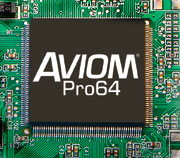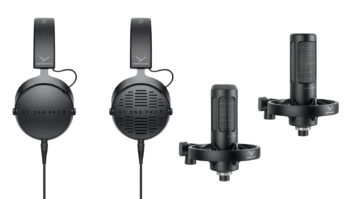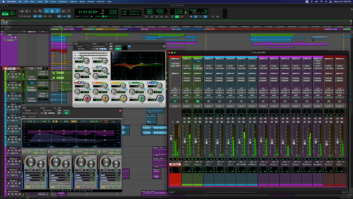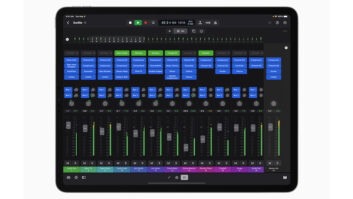
Whether moving audio files around in a studio complex or offering shared access to stage feeds for front-of-house/monitors/recording/broadcast duties during a live performance, using networked audio makes a great deal of sense. Unfortunately, the process can be daunting. Dealing with a maze of hubs, routers, switchers, interconnects and servers might seem so simple to computer techs, but the process can baffle many pro audio users.
Aviom’s custom Pro64 ASIC provides the core of the A-Net Pro network protocol, handling up to 128 channels.
Formed by a number of ex-Ensoniq engineers, Aviom appeared on the scene in 2002 with its A-16 Personal Monitor Mixing System, which distributed 16 channels of audio over A-Net, a proprietary, Ethernet-style protocol. Offering a simple system of distributing channel feeds and submixes to individual mixing stations — thus allowing musicians to create their own cue mixes — the A-16 won acclaim with the pro audio community and is now used in studios, tours, symphonies and houses of worship worldwide.
The A-16 is a 16-channel, single-direction system, so it only uses one pair of the four pairs on a standard Cat-5 cable. Aviom expanded the technology with its 64-channel AN Series of digital snake products, which use all four of Cat-5’s wire pairs. The system can be set up as single or bi-directional, but send/returns are allocated in 16-channel blocks, offering 64×0, 48×16 and 32×32 (or smaller) configurations.
At AES in San Francisco, Aviom announced A-Net Pro, a more robust version of the original A-Net protocol. The first-generation A-Net has the power that many users and systems require, and the company will continue to support and create new products based on this version of the protocol. However, A-Net can’t do everything, and A-Net Pro was developed to support larger, more complex and more varied audio networks than first-generation A-Net, while still offering uncompressed, low-latency audio in an easy-to-use, plug-and-play network.
“A-Net Pro features significantly increased capacity: up to 64 24-bit/48kHz audio channels on a single-wire pair, which on Cat-5 means up to 256 channels on a single cable,” explains Aviom’s Chandler Collison, while adding that “the protocol is not typically designed to run with 256 channels. Its two main modes of operation are 64 channels distributed throughout the network, regardless of the location of an input or output module, so there are no upstream and downstream signal flow limitations in that mode. The other major mode is bi-directional with 128 channels. With 64 channels in each direction, audio can be loaded into or out of the streams at any module. There’s no limitation on the number of audio sources in your installation. The only restriction is you can’t have more than 64 in either direction at any one point.”
A-Net Pro is based around an Aviom-designed custom Pro64 ASIC chip that can handle up to 128 channels, and the company has been talking to numerous pro audio companies about incorporating A-Net Pro into their products. “To reach the maximum 256 channels, or 128 channels bi-directionally, each [I/O] module would need a second A-Net Pro ASIC,” says Collison. The 24-bit system supports variable sample rates, with a 1x mode for 44.1/48 kHz, and 2x and 4x modes handling up to 192 kHz, with a corresponding reduction in channel count.
Another A-Net Pro feature is its dedicated bandwidth provision for what Aviom calls “virtual data cables,” serial data slots that can be used for a combination of RS-232, MIDI and GPIO (general purpose inputs/outputs). The information is distributed and available throughout the network, and would be ideal for applications such as system control, lighting controllers or MIDI. In fact, with the latter, A-Net Pro overcomes MIDI’s short cable limitation and expands it to A-Net’s 500-foot maximum. A-Net Pro is a hybrid data/audio network, but its first priority remains audio: The non-audio data fits around the audio and not vice-versa.
The Pro64 ASIC offers routing flexibility. “There’s a full crosspoint switch on both input and output, and the A-Net Pro protocol supports single-channel granularity so you don’t have to pull down a 16-channel packet like the original A-Net system,” says Collison. This way, the system can support digital patchbay functions or operate as a traditional matrix on a large console, providing the equivalent of two virtual 64×64 console matrices on each chip.
A-Net Pro can also be managed or controlled via a PC. “We’re designing our modules to be as plug-and-play as possible, but there’s a balance here,” Collison adds. “Because A-Net Pro has so much power and versatility, it’s difficult to design a control interface that fits on a single-rackspace chassis. That’s really where the PC interface comes in, especially for managing routings and system presets.”
The routing possibilities are formidable. Users could control whether input sources connected to A-Net Pro hardware modules are loaded into an A-Net Pro stream or not. With no limit on the number of audio sources that can be connected to the network, the user decides which 64 signals (or 128 in a snake) are distributed. Any audio not loaded into an A-Net stream is still live audio and can be monitored and processed locally. For example, a band could be working in Studio A, connected to the network but not loaded into the A-Net stream, while a band in another room uses the network space. For the next set of sessions, Studio A could use the network without re-patching, and the same scenario would apply equally well to multiple band setups in a live situation.
The first deliveries of the Pro64 ASIC will be available to third-party companies in mid-2005, and Aviom will unveil its first A-Net Pro hardware products in the third quarter of 2005. For more information, visit Aviom at www.aviom.com.
George Petersen is Mix’s editorial director.







